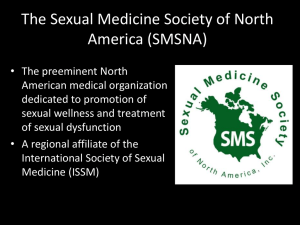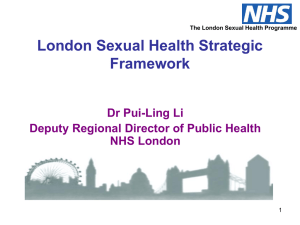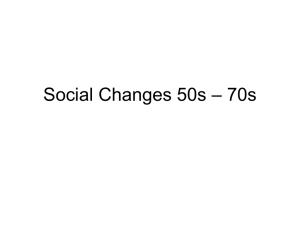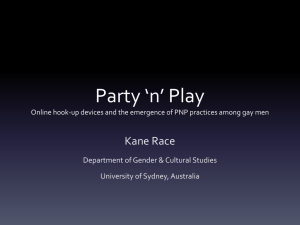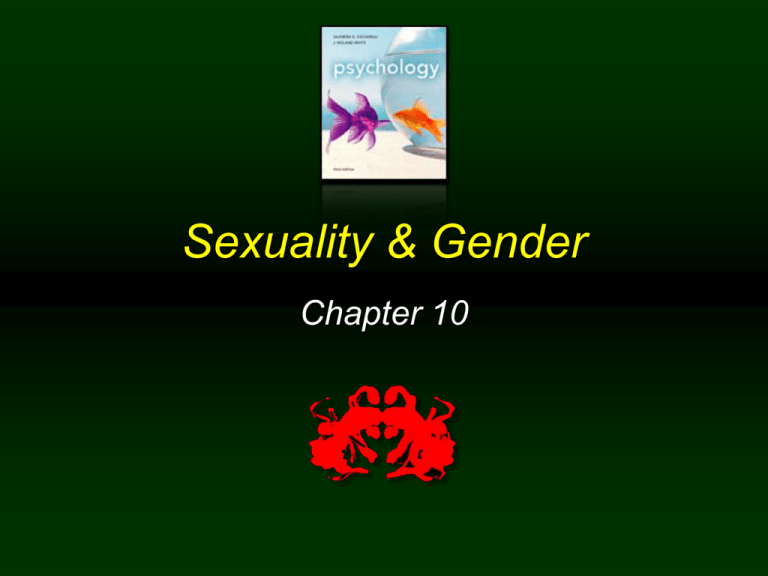
Sexuality & Gender
Chapter 10
Chapter 10 Menu
• Physical differences between males and females
• Gender
•
Influence of biology and learning on gender development
• Theories on gender role learning
• Gender stereotyping
• Androgyny
•
Gender differences in thinking, social behavior, and personality
• Controversy of treatment of intersexed infants
• Bodies of men and women during sexual intercourse
•
Masters and Johnson and the human sexual response
• Kinsey’s study of human sexual behavior
• Findings of the Janus Report
• Sexual orientations and how they develop
•
Sexual dysfunctions caused by physical problems or stress
• Sexual dysfunctions called paraphilias
• Sexually transmitted diseases
• Protect against and prevent STDs
Male & Female Physical Differences
• Primary sex characteristics – sexual organs present
at birth and directly involved in human reproduction.
• Vagina - the tube that leads from the outside of a
female’s body to the opening of the womb.
• Uterus - the womb in which the baby grows during
pregnancy.
• Ovaries - the female sexual glands.
• Testes (testicles) - the male sex glands.
• Scrotum - external sack that holds the testes.
• Prostate gland - gland that secretes most of the fluid
holding the male sex cells or sperm.
Menu
Male & Female Physical Differences
• Primary sex characteristics – sexual
organs present at birth and directly
involved in human reproduction.
• Female Primary Sex Characteristics
• Vagina - the tube that leads from the outside of
a female’s body to the opening of the womb.
• Uterus - the womb in which the baby grows
during pregnancy.
• Ovaries - the female sexual glands.
Menu
Male & Female Physical Differences
• Male Primary Sex Characteristics
•
•
•
•
Penis – male sex organ.
Testes (testicles) - the male sex glands.
Scrotum - external sack that holds the testes.
Prostate gland - gland that secretes most of the
fluid holding the male sex cells or sperm.
Menu
Physical differences between males & females
Menu
Male & Female Physical Differences
• Secondary sex characteristics - sexual organs and traits
that develop at puberty and are indirectly involved in
human reproduction.
• Female Secondary Sex Characteristics
• Growth spurt
• Onset of the menstrual cycle - monthly shedding of the blood
and tissue that line the uterus in preparation for pregnancy
when conception does not occur
• Breast development
• Mammary glands - glands within the breast tissue that
produce milk when a woman gives birth to an infant.
• Widening hips
• Pubic hair
• Fat deposits
• Further growth and development of the uterus, vagina, and
ovaries
Menu
Male & Female Physical Differences
• Male Secondary Sex Characteristics
•
•
•
•
•
•
Enlarged larynx (Adam’s apple)
Deepening voice
Facial and chest hair
Pubic hair
Coarser skin texture
Large increase in height
• Estrogens - female sex hormones.
• Androgens - male sex hormones.
Menu
Gender
• Gender- the psychological aspects of
being male or female.
• Gender roles - the culture’s
expectations for masculine or
feminine behavior, including
attitudes, actions, and personality
traits associated with being male or
female in that culture.
• Gender typing - the process of
acquiring gender role characteristics.
• Gender identity - the individual’s
sense of being male or female.
Menu
Biology & Learning Influences on Gender
• Biological influences - hormones and
chromosomes
• Environmental influences - parenting,
surroundings, and culture on the
formation of gender identity.
Menu
Gender Roles
• Social learning theory - gender identity is
formed through reinforcement of appropriate
gender behavior as well as imitation of gender
models.
• Gender schema theory - theory of gender
identity acquisition in which a child develops a
mental pattern, or schema, for being male or
female and then organizes observed and
learned behavior around that schema.
(combines social learning theory with
cognitive development)
Menu
Theories on gender role learning
Androgyny - characteristic of possessing the most positive personality
characteristics of males and females regardless of actual sex.
Menu
Gender Stereotyping
• Stereotype - a concept held about a person
or group of people that is based on
superficial, irrelevant characteristics.
• Gender stereotype - a concept held about a
person or group of people that is based on
being male or female.
• Sexism - prejudice about males and/or
females leading to unequal treatment.
• Benevolent sexism - acceptance of positive
stereotypes of males and females that leads
to unequal treatment.
Menu
Androgyny
Characteristic of possessing the most positive
personality characteristics of males & females
regardless of actual sex.
Menu
Gender differences in thinking, social behavior, and personality
Other Male & Female Differences
• Cognitive differences - male advantage
in mathematical and spatial skills and a
female superiority in verbal skills
(decreasing differences).
• Emotional expression - males tend to
talk with each other in a “report” style,
whereas females tend to talk to each
other in a “relate” style.
Menu
Gender differences in
thinking, social
behavior, and
personality
Menu
Intersexed Infants page 380
• Hermaphroditism - the condition of
possessing both male and female
sexual organs.
• Intersex - alternate term for
hermaphroditism.
• Intersexed, intersexual - a person
who possesses ambiguous sexual
organs, making it difficult to
determine actual sex from a visual
inspection at birth.
Menu
Stages of Human Sexual Response
• Excitement – beginning of sexual
arousal.
• Plateau – physical changes beginning in
first stage continue.
• Orgasm - a series of rhythmic
contractions of the muscles of the
vaginal walls or the penis, also the third
and shortest phase of sexual response.
• Seminal fluid - fluid released from the penis
at orgasm that contains the sperm.
Menu
Stages of Human Sexual Response
• Resolution - the final phase of the sexual response
in which the body is returned to a normal state.
• Refractory period - time period in males just
after orgasm in which the male cannot become
aroused or achieve erection.
Menu
Menu
Menu
Masters and Johnson Study
• Used volunteers, some of whom were
prostitutes, and both observed and
measured their physiological responses
during all phases of sexual intercourse.
Menu
Kinsey Studies
• Series of sexual behavior surveys in the
late 1940s and early 1950s
• Revealed some highly controversial
findings about the kinds of sexual
behavior common among people in the
United States, including:
• Homosexuality
• Premarital sex
• Extramarital sex
Menu
Kinsey’s study of human sexual behavior
Menu
Kinsey’s study of human sexual behavior
Menu
Menu
Findings of the Janus Report
Janus Report
• Large-scale survey of sexual behavior
in the United States in 1990s.
• Did NOT differ widely from those of
Kinsey but looked at many more types
of sexual behavior and factors related to
sexual behavior, including:
• Sexual deviance - behavior that is
unacceptable according to societal norms
and expectations.
Menu
Menu
Sexual orientations and how they develop
Sexual Orientation
• Sexual orientation - a person’s sexual attraction
preference for members of a particular sex.
• Heterosexual - person attracted to the opposite
sex.
• Homosexual - person attracted to the same sex.
• Bisexual - person attracted to both men and
women.
Menu
Sexual orientations and how they develop
Menu
Sexual dysfunctions causes by physical problems or stress
Sexual Dysfunction
• Sexual dysfunction - a problem in
sexual functioning.
• Organic or stress-induced dysfunction
- sexual problem caused by physical
disorder or psychological stress.
• Hypoactive sexual desire, sexual
aversion, female sexual arousal disorder,
male erectile disorder, male orgasmic
disorder, female orgasmic disorder,
premature ejaculation, vaginismus, and
dyspareunia.
Menu
Sexual dysfunctions causes by physical problems or stress
Menu
Sexual dysfunctions called paraphilias
Paraphilias
• Paraphilia - a sexual disorder in which the
person’s preferred method of sexual arousal
and fulfillment is through sexual behavior that
is unusual or socially unacceptable.
• Pedophilia - deriving sexual arousal and pleasure
from touching or having sexual relations with
prepubescent (nonsexually mature) children or
fantasizing about such contact.
• Pedophile - a person who has recurring sexual thoughts,
fantasies, or engages in sexual actions toward
prepubescent (nonsexually mature) children.
Menu
Other Paraphilias
Menu
Sexually-Transmitted Diseases
• Sexually transmitted diseases - can
affect the sexual organs and the ability
to reproduce and may result in pain,
disfigurement, and even death.
• Common bacterial sexually transmitted
diseases are Chlamydia, syphilis, and
gonorrhea.
• Treatable with antibiotics.
Menu
Sexually-Transmitted Diseases
• Viral sexually transmitted diseases include
genital herpes (caused by the herpes simplex
virus that also causes cold sores) and genital
warts (caused by the human papillomavirus).
• Neither can be cured and both can lead to
complications such as increased risk of cancer.
• AIDS or acquired immune deficiency
syndrome - sexually transmitted viral disorder
that causes deterioration of the immune
system and eventually results in death due to
complicating infections that the body can no
longer fight.
• There are drug treatments but no cure.
Menu
Menu
How to Protect Spread of STDs
•
•
•
•
•
Using condoms
Having only one partner
Abstaining from sex
Avoiding IV drug use
Knowing the symptoms of the various
diseases
• Getting regular physicals
Menu
Menu
The End




